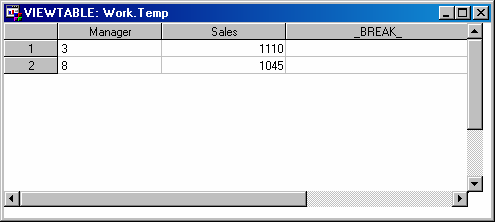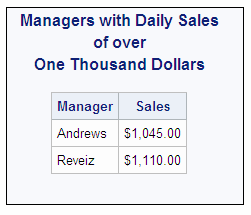REPORT Procedure
- Syntax

- Overview
- Concepts
- Using
- Results
- Examples
 Selecting Variables for a ReportOrdering the Rows in a ReportUsing Aliases to Obtain Multiple Statistics for the Same VariableConsolidating Multiple Observations into One Row of a ReportCreating a Column for Each Value of a VariableDisplaying Multiple Statistics for One VariableStoring and Reusing a Report DefinitionCondensing a Report into Multiple PanelsWriting a Customized Summary on Each PageCalculating PercentagesHow PROC REPORT Handles Missing ValuesCreating and Processing an Output Data SetStoring Computed Variables as Part of a Data SetUsing a Format to Create GroupsSpecifying Style Elements for ODS Output in the PROC REPORT StatementSpecifying Style Elements for ODS Output in Multiple StatementsUsing Multilabel FormatsUsing the WIDTH= and CELLWIDTH= Style Attributes with PROC REPORT
Selecting Variables for a ReportOrdering the Rows in a ReportUsing Aliases to Obtain Multiple Statistics for the Same VariableConsolidating Multiple Observations into One Row of a ReportCreating a Column for Each Value of a VariableDisplaying Multiple Statistics for One VariableStoring and Reusing a Report DefinitionCondensing a Report into Multiple PanelsWriting a Customized Summary on Each PageCalculating PercentagesHow PROC REPORT Handles Missing ValuesCreating and Processing an Output Data SetStoring Computed Variables as Part of a Data SetUsing a Format to Create GroupsSpecifying Style Elements for ODS Output in the PROC REPORT StatementSpecifying Style Elements for ODS Output in Multiple StatementsUsing Multilabel FormatsUsing the WIDTH= and CELLWIDTH= Style Attributes with PROC REPORT
Example 12: Creating and Processing an Output Data Set
| Features: |
|
| Other features: |
Data set options: WHERE= |
| Data set: | GROCERY |
| Format: | $MGRFMT |
Details
This example uses WHERE
processing as it builds an output data set. This technique enables
you to do WHERE processing after you have consolidated multiple observations
into a single row.
The first PROC REPORT
step creates a report (which it does not display) in which each row
represents all the observations from the input data set for a single
manager. The second PROC REPORT step builds a report from the output
data set. This report uses line-drawing characters to separate the
rows and columns.
Program to Create Output Data Set
libname proclib
'SAS-library';
options fmtsearch=(proclib);
proc report data=grocery nowd
out=temp( where=(sales gt 1000) );
column manager sales;
define manager / group noprint; define sales / analysis sum noprint; run;
Program Description
Specify the format search library.The SAS system option FMTSEARCH= adds the SAS library
PROCLIB to the search path that is used to locate formats.
Specify the report options and columns. The NOWD option runs PROC REPORT without the REPORT
window and sends its output to the open output destinations. OUT=
creates the output data set TEMP. The output data set contains a variable
for each column in the report (Manager and Sales) as well as for the
variable _BREAK_, which is not used in this example. Each observation
in the data set represents a row of the report. Because Manager is
a group variable and Sales is an analysis variable that is used to
calculate the Sum statistic, each row in the report (and therefore
each observation in the output data set) represents multiple observations
from the input data set. In particular, each value of Sales in the
output data set is the total of all values of Sales for that manager.
The WHERE= data set option in the OUT= option filters those rows as
PROC REPORT creates the output data set. Only those observations with
sales that exceed $1,000 become observations in the output data set.
Output Showing the Output Data Set
Program That Uses the Output Data Set
proc report data=temp box nowd; column manager sales; define manager / group format=$mgrfmt.; define sales / analysis sum format=dollar11.2; title 'Managers with Daily Sales'; title2 'of over'; title3 'One Thousand Dollars'; run;
Program Description
Specify the report options and columns, define the group
and analysis columns, and specify the titles. DATA= specifies the output data set from the first
PROC REPORT step as the input data set for this report. The BOX option
draws an outline around the output, separates the column headings
from the body of the report, and separates rows and columns of data.
The TITLE statements specify a title for the report.

